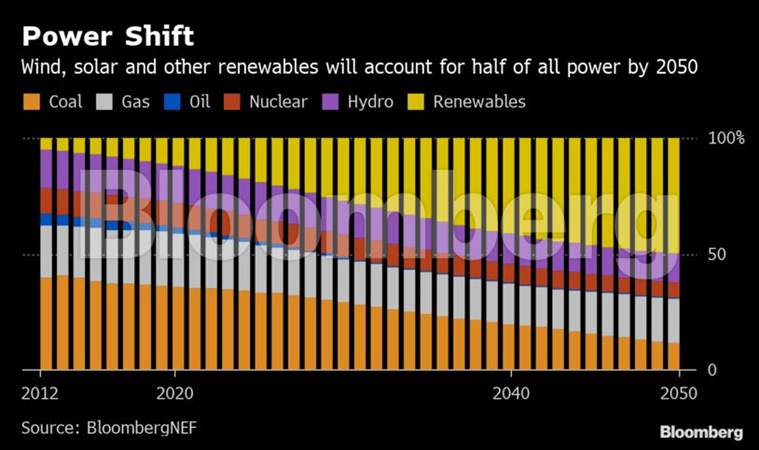
Nearly half the world’s electricity will come from renewable energy by 2050 as costs of wind, solar and battery storage continue to plummet.
That titanic shift over the next three decades will come as electricity demand increases 62% and investors pump $13.3 trillion into new projects, according to a report released Tuesday by BloombergNEF.
The move away from fossil fuel has sweeping implications for energy markets and the fight to stave off climate change. Wind, solar and batteries are poised to enable the power sector to meet its share of emission cuts required under the Paris climate agreement, at least until 2030, according to BNEF. But after that, nations will need other technologies to make deeper cuts at a reasonable cost, said Matthias Kimmel, the lead analyst on the report.
“To get emissions where we want them to be, we need something else,” Kimmel said in an interview.

By 2050, solar and wind will supply almost 50% of the world’s electricity, with hydro, nuclear and other renewable energy resources providing another 21%, according to BNEF. Coal will be the biggest loser in the power sector, with its share of global generation plunging from 37% today to 12% in 2050, BNEF said.
Those other renewables could include geothermal systems, fuel cells and devices that harvest energy from ocean waves and tides. But it’s unclear which, if any, will be economical to deploy on a mass scale. And other low-emission technologies could be developed between now and 2030.
BNEF sees a more ambitious transition to clean power than one oil giant BP Plc laid out in its 2019 Energy Outlook. BP foresees renewables generating about 30% of power by 2030 under its “evolving transition” scenario, while BNEF calls for 41%. Under a different scenario, however, BP is even more bullish than BNEF, saying renewables could hit 50% by 2040.
BNEF forecasts that many nations can cut power-sector emissions through 2030 in line with goals set in Paris to limit the increase in world temperatures to 2 degrees Celsius (3.6 degrees Fahrenheit). And they can do that without additional subsidies for solar and wind, BNEF said.